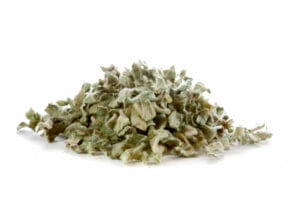Mullein: A smooth & polyvalent herb
Verbascum thapsus
Also referred as:
Mullein, Common Mullein
🍃 Texture when dried
Soft and velvety
👅 Taste
Neutral taste
❔ Usage
Herbal tea, smoking blends and ointments
💨 Smoke
Lots of smoke
🗜 Harshness
Smooth
⚡ Effects
Calming effects. As a tea, mostly know for relieving respiratory problems

Table of Contents
Introduction
Mullein, also known as Verbascum thapsus, is a fuzzy-leaved medicinal herb that thrives in dry, sunny environments. It’s been used for centuries in natural remedies and as a soothing tea or smoke blend ingredient. With its bright yellow flowers, mullein is not only functional but also adds a touch of beauty to gardens and wild landscapes.
Smokably products with Mullein :
-
 MulleinCAD $8.00 – CAD $12.00
MulleinCAD $8.00 – CAD $12.00 -
 Skull Island▸ Herbal Blend from Skullcap, Mullein, Damiana, Lavender, RoseCAD $12.00 – CAD $18.00
Skull Island▸ Herbal Blend from Skullcap, Mullein, Damiana, Lavender, RoseCAD $12.00 – CAD $18.00 -
 The Holy Blend ▸ Holy Basil, Blue Lotus, Red Raspberry, Mullein, Lemon BalmCAD $14.00 – CAD $20.00
The Holy Blend ▸ Holy Basil, Blue Lotus, Red Raspberry, Mullein, Lemon BalmCAD $14.00 – CAD $20.00 -
 Classic Blue Lotus BlendCAD $16.00 – CAD $22.00
Classic Blue Lotus BlendCAD $16.00 – CAD $22.00
Frequently asked questions
Is it common to smoke Mullein?
Yes, smoking mullein herb is relatively common. Many people appreciate its mild, smooth flavor and gentle, soothing properties. Mullein is often used as a base in herbal smoking blends or as an alternative to tobacco, providing a relaxing and enjoyable smoking experience without the addition of nicotine or other harmful chemicals.
Is Mullein smoked on its own or mixed with other herbs?
Mullein can be smoked on its own or mixed with other herbs to create a personalized blend. When used as a base in herbal smoking mixes, it adds a smooth, gentle texture that complements the flavors and properties of other herbs. Some herbs that pair well with mullein include lavender, damiana, and chamomile, which can provide a relaxing and aromatic smoking experience. Combining mullein with multiple herbs allows you to customize the mix to better suit your preferences and desired effects.
Can Mullein help you quit smoking?
Some people find that smoking mullein can be a helpful aid in their transition away from tobacco. Its mild flavor and gentle properties offer a relaxing alternative to traditional cigarettes, without nicotine or other harmful chemicals. When used as part of a committed cessation plan, mullein may provide a support by serving as a satisfying, non-addictive substitute during the process of quitting tobacco. However, remember that quitting smoking is a personal journey and finding the best strategy for success might require trying different methods or seeking professional guidance.
Why do people enjoy Mullein ?
People enjoy Mullein for a variety of reasons.
- Mild, smooth flavor: Mullein’s gentle taste is pleasant and not overpowering, making it enjoyable on its own or as part of a blend.
- Soothing properties: Mullein is known to have a calming effect, which may contribute to a relaxing smoking or tea-drinking experience.
- Versatility: Mullein can be used as a base in herbal smoking blends, infused as a tea, or added to poultices and salves for external applications.
- Tobacco alternative: Mullein offers a nicotine-free option for those looking to reduce or quit tobacco intake.
- Easy cultivation: Mullein is a resilient plant that grows well in various environments, making it readily available as a homegrown or wild-crafted herb.
- Aesthetic appeal: With its fuzzy leaves and bright yellow flowers, mullein adds beauty to gardens and wild landscapes.
NB. Anecdotal or historical claims should not be construed as health claims. Always consult a health specialist prior to oral consumption of any herb. Consumption of any herbs might have side effects.
How do you make a tea out of Mullein ?
To make a herbal tea out of Mullein, you can follow these simple steps:
- Gather mullein leaves and/or flowers: You can use fresh or dried mullein, which can either be organically sourced or purchased from a reputable supplier. Both the leaves and flowers can be used for tea, each providing a slightly different taste and properties.
- Prepare the ingredients: If using fresh leaves, gently wash and pat them dry. For dried leaves and flowers, measure out 1-2 tablespoons per 8 ounces of water.
- Heat the water: Bring water to a near boil (around 190°F to 200°F), then remove from the heat.
- Steep the mullein: Add the prepared mullein to a tea infuser, teapot, or directly into the hot water. Cover and steep for about 10-15 minutes. The longer the steeping time, the more potent the tea will be.
- Strain and serve: After steeping, strain the tea to remove any plant matter, then pour into a cup. You can add honey or a natural sweetener to taste if desired.
Mullein tea is known for its mild, earthy flavor with subtle hints of sweetness. It is a popular form of consumption for this herb, often enjoyed for its soothing properties and calming effects. Some people also believe that the tea supports respiratory comfort, although specific health claims cannot be made. The warm, gentle aroma and taste make mullein tea a comforting beverage, especially during cool nights or when seeking a moment of relaxation.
What does Mullein look like?
Mullein (Verbascum thapsus) is an eye-catching, biennial herb that exhibits a unique appearance. The plant has a few distinct features, such as:
- Tall flower stalk: Mullein can reach heights between 4 and 10 feet, with some even growing taller. The central stalk is typically sturdy and becomes thick as the plant matures.
- Fuzzy leaves: The large, oval-shaped leaves have a soft, fuzzy texture, giving them a velvety, silver-green appearance. These leaves typically grow in a rosette pattern at the base of the plant, with smaller leaves sprouting along the flower stalk.
- Yellow flowers: During its blooming phase (usually in the second year), mullein produces small, bright-yellow flowers that grow on dense, elongated spikes. These flowers attract pollinators like bees and butterflies, adding to the plant’s beauty and ecological significance.
- Seed capsules: After flowering, the seed capsules take shape, which eventually dry and release numerous tiny seeds that facilitate the spread and growth of new mullein plants.
The combination of its tall stalk, velvety leaves, and bright yellow flowers makes mullein easily recognizable and an attractive addition to gardens or wild landscapes.
How has Mullein been used historically?
Historically, mullein has been valued for its versatile applications and is known to have a long history of use across various cultures. Some prominent ways it has been used include:
1. Medicinal uses: Ancient Greeks, Romans, and Native Americans have used mullein for various ailments, often in herbal infusions, poultices, or oils. It has been typically associated with respiratory support, wound healing, and skin irritation relief, but no specific health claims can be made.
2. Smoking blends: Mullein has been utilized as a base for herbal smoking blends or as a tobacco substitute due to its mild, smooth flavor and gentle properties.
3. Candle wicks and lanterns: The dried, oil-soaked mullein stalks were used as candle wicks or torches in ancient Rome because they can retain their stiffness and burn slowly.
4. Spiritual practices: In some cultures, mullein has been linked to protection and warding off of negative energies. It has been used in various rituals, spiritual ceremonies, and by practitioners of folk traditions.
5. Dyes and cosmetic use: Mullein flowers have been employed to create natural yellow dyes for fabrics and hair, while its leaves, being rich in mucilage, have been used in cosmetic products for their skin-soothing benefits.
6. Wildlife support: The bright yellow flowers of mullein attract pollinators like bees and butterflies, playing a vital role in maintaining ecological balance.
The diverse historical uses of mullein highlight its versatility and longstanding importance in traditional practices, herbalism, and cultural beliefs.





